This week the Treasurer released the Final Report from the Review into Australia’s central bank: An RBA Fit for the Future. The Review makes 51 specific recommendations including the establishment of separate boards for monetary policy and governance of the central bank, an expert Monetary Policy Board, a smaller number of monetary policy meetings each year and a more robust approach to corporate governance of the institution itself. Notably, the Review did not recommend any major changes to the flexible inflation target framework, the inflation target itself, or to the operational independence of the central bank. That means this week’s announcement should have no significant near-term implications for the trajectory of the cash rate.
In his initial response, the Treasurer said the government agreed in-principle with all of the Review’s recommendations and would ‘now work with the RBA, the parliament and other stakeholders to implement them.’ Separately, he also announced the appointment of two new board members. The RBA has welcomed the Review and said it will now work with the Treasurer on an updated Statement on the Conduct of Monetary Policy.
There is more detailed discussion of some of the Review’s recommendations below, but my quick take here is that this can largely be seen as the introduction to the RBA of central banking governance ‘best practice’ in the form that has broadly applied across its peers between the end of the global financial crisis and the onset of the pandemic (such as the move to a dedicated monetary policy committee, the enhanced role for external experts, the shift for fewer monetary policy meetings and the aim to deliver more transparency). Since this is the first significant review into Australia’s central bank since the 1990s, this kind of governance update and upgrade was probably overdue. However, the Review largely refrains from grappling in detail with many of the new debates about the direction of central banking that have taken place following the pandemic. Consideration of these issues is largely restricted to a short discussion of climate change, where the Review recommends the RBA ‘should take account of climate risks but not use monetary policy to address them’ and Appendix 2, which briefly considers some alternative monetary policy frameworks that have been proposed.
In terms of the current monetary policy cycle, it was just a couple of weeks ago when the 4 April 2023 Monetary Policy Meeting of the RBA saw the central bank pause in the current cycle of rate hikes, breaking a run of 10 consecutive rate increases and a cumulative 350bp of monetary policy tightening. The publication this week of the minutes to that meeting outline the thinking behind that decision in more detail. They also make it clear that the intention here was a pause for assessment and not an end to the tightening cycle. As such, it’s quite possible that the 2 May 2023 Meeting could deliver another 25bp rate hike, with the final decision likely resting on the nature of the Q1 quarter CPI release, due next Wednesday. Based on the decline in the monthly CPI readings for January and February, that release is likely to deliver a significant drop in the headline rate. But there is more uncertainty around the prospects for underlying inflation. A parallel drop there and the RBA will be minded to continue its pause for at least another month. But if the release shows that underlying inflation remains stubbornly high, then Martin Place might feel compelled to deliver another rate hike the following week. We dissect the minutes in more detail below.
This week also brought the publication of our H1:2023 Director Sentiment Index (DSI). The headline index remained in negative territory in the first half of this year, despite an improvement in directors’ assessments of international economic conditions. Respondents cited the top economic challenges facing Australian businesses as inflation and rising interest rates and labour shortages, while cyber-crime is still the main issue keeping directors awake at night. Readers can find more analysis of the many insights from the DSI below. Sincere thanks to those of you who were able to complete the survey. It’s great to get your views and we do appreciate the time commitment involved.
Finally, this week on The Dismal Science podcast, we do a deep dive on the RBA review and what it means for the future of monetary policy in Australia.
Dear reader, there is a lot of detail below – even more than usual! – so, unless you are in the mood for a deep dive, please do feel free just to stick to the headline section this week. But for those of you who would like (considerably) more detail, do read on…
Bringing central banking ‘best practice’ to Martin Place
Treasurer Jim Chalmers announced an independent review of the RBA on 20 July 2022, kicking off the first wide-ranging examination of Australia’s central bank since the current set of monetary policy arrangements were introduced in the 1990s. The Review was asked to consider the RBA’s objectives, policy implementation, governance processes and public communications, as well as the relationship between monetary, fiscal and macroprudential policy settings. The final report – An RBA fit for the Future – has now been published, and the Treasurer and RBA have released their initial responses. RBA Governor Lowe also held a press conference in which he gave some further comments.
What did it all mean?
Overall, the Review did not recommend any radical changes to the operation of monetary policy in Australia. It affirmed the importance of the RBA’s operational independence, confirmed the central bank should stick with its current policy approach of flexible inflation targeting and declared the inflation target should remain unchanged at 2 to 3 per cent. It also refrained from adding any new objectives to the RBA’s mandate (for example, relating to climate change) and said Martin Place should stay focused on the dual objectives of inflation and full employment. Although it did propose legislating the RBA’s role in achieving financial stability.
What the Review mainly did do was to upgrade the RBA’s governance model to something closer to what we might think of as current central banking best practice. That means the establishment of separate boards for monetary policy and for the overall governance of the central bank as an institution, a greater role for external expert advice, a reduction in the frequency of monetary policy meetings, adjustments to the RBA’s approach to communications including more information and more messaging from a broader set of representatives, and some suggestions to deliver greater transparency. The Review also sought to upgrade corporate governance standards more generally around the management of the institution itself, drawing on the Australian Securities Exchange Corporate Governance Principles and Recommendations, for example, in the form of recommendations around delineating the roles and responsibilities of boards and management, the role of independent directors, the role of an Audit and Risk Committee and the establishment of Board charters.
What the Review did not do a great deal of was to engage in detail with many of the debates about the future of central banking that have arisen in the aftermath of the pandemic. To be fair, it did canvass two of the most important of these: The pros and cons of some of the potential alternative frameworks to flexible inflation targeting got an Appendix and the implications of climate change for central banks received some discussion. But this was certainly not the main thrust of the Review. Instead, these and related matters will have to wait on the next Review – something that the current one recommends should happen on a regular five-year cycle from now.
Reviewing monetary policy performance
The Review’s starting point is an acceptance that, overall, the RBA has done a decent job. The authors acknowledge that over the past three decades, inflation has averaged around the mid-point of the central bank’s target range, that the variability of output and unemployment had been lower than in earlier decades, and that ‘Australia’s very good performance is at least on par with other comparable economies.’ The RBA’s actions are judged to ‘have been successful overall’ with ‘a particularly critical role during crises, where it has acted decisively and effectively’, and the Review says that ‘Australia’s existing monetary policy and financial stability frameworks have served Australia well in recent decades.’
However, after focusing on three of the more contentious episodes of recent monetary history (the low inflation period between 2016 and 2019 when the average headline inflation rate of 1.7 per cent and average trimmed mean inflation rate of 1.6 per cent were both well below the inflation target; the unorthodox policy response to the pandemic in the form of yield targets, (calendar-based) forward guidance and bond purchases; and the recent increase in inflation), the Review finds several reasons to be critical of recent RBA performance. Highlighted shortcomings include the approach to communications; the lack of challenge to policy ideas from a Reserve Bank board that the Review thinks would have benefited from more specialist expertise, support and time to evaluate the proposed policies; the nature of decision-making arrangements; and the need for a deeper consideration of monetary policy strategy, risks and opposing views, including by encouraging robust debate and challenge.
Based in part on lessons from these three experiences, the Review identifies four big ways in which it thinks the governance, monetary policy framework, culture and systems of Australia’s central bank should be reinforced. These changes are intended to ‘fortify an already effective institution, making it better placed to face the challenges of the future.’
1. A clearer monetary policy framework
While the Review thinks the current monetary policy framework is ‘fundamentally sound’ it also recommends that it ‘should be more clearly defined and regularly assessed for updates’. Key recommendations here include:
- Affirming the RBA’s independence and clarifying its statutory monetary policy objectives. (Recommendation 1, or R.1).
- The Review also recommends repealing the power of the Government to override decisions of the Reserve Bank Board (R.1.1).
- Agreeing in the Statement on the Conduct of Monetary Policy that the RBA should now have the dual monetary policy objectives of price stability and full employment. The current (2016) statement includes the economic prosperity and welfare of the people of Australia as a third objective, but the Review says this should instead be treated as an overarching purpose for the RBA, rather than as a separate objective for monetary policy. (R.1.2)
- Giving equal consideration to price stability and full employment in setting monetary policy. (R.2.1)
- Retaining the RBA’s current flexible inflation target of 2 to 3 per cent while clarifying how it operates (R.2).
- The Review judges that ‘flexible inflation targeting remains the best operational framework for monetary policy’ and that it has ‘a good track record and is well established and understood’, and believes this will continue to be the case in a future environment, where supply shocks become more common.
- The Review’s authors argue there is insufficient evidence available to demonstrate that alternative frameworks (such as price levels or nominal income targeting) would do a better job in practice than the current approach. See also Appendix 2 of the Review.
- It also argues that keeping the current target of 2 to 3 per cent supports well-anchored inflationary expectations.
- The Review does note that the current wording of the RBA’s target refers to keeping inflation between 2 and 3 per cent ‘on average, over time’ which it argues makes it harder to judge whether the target is in fact being met. It therefore recommends dropping this reference and instead requiring the RBA to explain its use of the ‘flexible framework’ by regularly explaining to the public: How long inflation is expected to be materially away from the mid-point of its target and how quickly it aims to return inflation to target; how long labour market conditions are expected to deviate from full employment; and how and why the central bank is choosing to balance these two targets. In this context, the Review says the RBA should also explain how, if at all, other key factors such as financial vulnerabilities have influenced its policy decisions. (R.2.2)
- Recognising the importance of both monetary and fiscal policy for macroeconomic outcomes in the Statement on the Conduct of Monetary Policy.
- The Review recommends promoting a better understanding of the relative roles of fiscal and monetary policy, including through increased joint work between Treasury and the RBA. (R.3)
- It also recommends the RBA publish a framework for the use of additional monetary policy tools, with the Statement on the Conduct of Monetary Policy setting out expectations around transparency, assessments of costs and benefits, risk management, exit strategies and discussions on the appropriateness of fiscal policy as an alternative. (R.3.3)
- Introducing five-yearly reviews of the RBA’s monetary policy framework and tools. (R.4)
- Legislating the RBA’s financial stability role (R.5) and reinforcing cooperation arrangements for financial stability policy, including the RBA giving formal advice to APRA for the use of macroprudential tools (R.5.6)
2. Stronger monetary policy decision making accountability
Here the Review recommends that monetary policy decision making ‘be strengthened, drawing on more expertise and with processes that promote deeper contestability of ideas’. It argues that the RBA Board’s ‘composition and decision-making processes have not sufficiently enabled it to shape policy decisions, strategy, and the RBA’s underlying analysis and judgements’. Key recommendations here include:
- Constituting an expert Monetary Policy Board with greater economic expertise and participation in decision making, while maintaining diverse perspectives and knowledge. (R.8)
- The Review says the new Monetary Policy Board should comprise the Governor, Deputy Governor, Treasury Secretary and six external members and be chaired by the Governor. (R.8.2)
- The Treasury Secretary should remain a member of the Board, but should act independently of government, and the RBA Act should specify that the Secretary cannot be directed by the Treasurer in this regard. (R.8.3)
- It recommends that members have expertise in areas such as open-economy macroeconomics, the financial system, labour markets, or the supply side of the economy, and in the context of decision making under uncertainty’. (R.8.4)
- The appointment process should be made more open, transparent and skills based, positions should be advertised and a panel comprising the Treasury Secretary, the Governor and a third party should recommend options for suitable candidates to the Treasurer. (R.8.5)
- Members could include business leaders or others with relevant expertise alongside academic and professional economists. However, the Review stipulates that such members ‘should have sufficient knowledge, experience or training to make a significant and informed contribution to the formulation of monetary and financial system policy’. It thinks this minimum requirement could be set out in legislation. It also recommends the development and use of a skills matrix when considering appointments.
- Moving to a schedule of eight monetary policy meetings a year for the new Monetary Policy Board (the RBA currently meets 11 times a year to set the cash rate target) ‘to allow more time to consider the issues and engage with RBA staff within each meeting cycle’. (R.9.1)
- The Review argues that the longer meeting cycles should allow sufficient time for reflection and follow-up analysis, and also provide opportunities for members to hear the views of a wider range of RBA staff.
- The six external members of the Monetary Policy Board should have direct access to RBA staff for support. (R.9.2).
- The Monetary Policy Board should convene and engage with an expert advisory group on monetary policy. (R.9.4)
- Making monetary policy processes more transparent and more accountable. (R.10)
- The Governor should hold a press conference after each decision meeting (R.10.1), external board members should occasionally speak publicly about their work, including through at least one speech or public engagement each year (R.10.2), the public statement following each meeting should report unattributed votes (R.10.3), the RBA should publish more of the information underlying the board decisions, and board papers should be published after five years (R.10.4).
- Appointing a new Chief Communications Officer to boost the RBA’s strategic communications capability.
3. An open and dynamic RBA
The Review wants the RBA to ‘become more open and dynamic’. Key recommendations here include:
- Strengthening the RBA’s management, culture and operations (R.11).
o The Review says the RBA should appoint a Chief Operating Officer (COO), ‘focussed on improving systems and processes and creating a more agile organisation that better empowers staff’. (R.11.1)
- Improving leadership capability via a compulsory leadership training program, externally facilitated 360-degree feedback, and improved performance management. (R.11.2)
- Promoting constructive debate and openness to diverse views, including through more openness to external hires and diversity targets. (R.11.3)
- Developing a new research strategy overseen by the new Monetary Policy Board and established a monetary policy strategy team. (R.11.4)
4. More robust corporate governance
The Review says the RBA’s ‘corporate governance should be strengthened, with contemporary governance structures that better manage risk and drive change’. Key recommendations include:
- Establishing an RBA Governance Board with an external chair to support and oversee management, drawing on best practice governance (R.12).
- The Governance Board’s duties should include oversight of the RBA’s organisational strategy, finances, strategic staff planning and risk management (R.12.1)
- Membership should comprise the Governor, COO and five external members. An external member should be chair. (R. 12.3)
- It should have no role in monetary, financial stability, or payments policy, or the day-to-day running of the RBA.
One other recommendation of note relates to climate policy, where the Review says:
- The RBA should take account of climate risks but not use monetary policy to address them (R.7). The Review’s view is that ‘Monetary policy tools do not provide a targeted response to the issue and using them for this purpose may inadvertently compromise the enduring objectives of price stability and full employment. Other government policies are better suited to target climate transition’.
RBA minutes suggest the Easter pause was a close call
The Minutes of the 4 April 2023 Monetary Policy Meeting of the Reserve Bank Board were published this week. They show members balancing the case for a further 25bp rate hike against the case for a pause. According to the minutes, the argument for the former:
‘…was again founded on the observation that inflation remained too high and the labour market was very tight…forecasts produced by the staff in February had inflation returning to the target range only by mid-2025 and that it would be inconsistent with the Board’s mandate for it to tolerate a slower return to target. These forecasts were conditioned on monetary policy being tightened a little further…members noted that imbalances between demand and supply in the housing and energy markets may limit how quickly inflation declines…Members also noted that most households were in a strong financial position and would be able to absorb higher prices and interest rates without needing to materially draw down on their savings’.
The case for additional tightening was also supported by the upgrade to near-term projections for population growth (which could have short-term inflationary consequences before potentially working due to reduce wage pressures and which could also imply that the fall in house prices might prove to be shallower than previously expected). Members were also concerned about an increased risk of larger wage increases in part of the Australian economy, including in the public sector, later this year. And despite the March turmoil in the US and Swiss banking sectors, members agreed that ‘the strength of the Australian banking sector meant that financial system resilience was not a consideration’.
Set against this, the case for leaving the cash rate target unchanged at the April meeting:
‘…rested on the observation that monetary policy had already been tightened significantly in a short period. The full effects…were yet to be observed, given the lags in the transmission of monetary policy. Members judged that monetary policy was already restrictive…required repayments on home loans, as a share of disposable income, were anticipated to rise to around their highest level on record…there were already signs that tighter monetary policy had contributed to a slowdown in the housing market, a material slowing in consumption growth and financial pressure for a segment of households with housing loans’.
In addition, the discussion canvassed the value of a pause ‘to gather more information on the economic outlook’ with upcoming data on quarterly inflation and new monthly data on the labour market and household spending. This new data, together with updated RBA forecasts to be presented at the May 2023 board meeting, ‘would be valuable in reassessing the economic outlook and the extent to which monetary policy would need to be tightened further’. A decision to pause would also return the RBA to something more like the typical pattern of monetary policymaking pre-pandemic.
Of course, we already know the outcome:
‘Members recognised the strength of both sets of arguments, but on balance agreed that there was a stronger case to pause at this meeting and reassess the need for further tightening at future meetings.’
That wording suggests that the April decision was a relatively close call. In addition, the discussion emphasises that board members felt that:
‘…it was important to be clear that monetary policy may need to be tightened at subsequent meetings and that the purpose of pausing at this meeting was to allow time to gather more information.’
The competing arguments put forward on 4 April together with the relative strength of last week’s domestic data releases suggest that the decision at the 2 May monetary policy meeting is likely to be a similarly tight one. That in turn implies that the upcoming Q1:2023 CPI reading, due next Wednesday, could prove to have a decisive impact both directly as well as indirectly via any impact on the RBA’s new forecasts due to be published on 5 May with release of the May 2023 Statement on Monetary Policy.
A selection of key findings from the latest DSI
Twice a year, every year, from H2:2011, the AICD has polled members with current directorships on issues covering the Australian and global economies, government policy and governance. The results from our latest H1:2023 Director Sentiment Index (DSI) capture the views of more than 1,300 directors polled across Australia between 22 February and 14 March 2023. That timing means the final days of the survey caught the start of the March 2023 banking crisis (Silicon Valley Bank was taken over by US Federal regulators on 10 March in the second largest banking failure in US history) but missed the regulator-led takeover by UBS of Credit Suisse on 19 March. Polling also preceded the RBA’s decision on 4 April 2023 to pause in the current cycle of monetary policy tightening.
The headline result from H1:2023 is that the overall index improved relative to the DSI reading in H2:2022, rising from minus 8.5 to minus 6.1. That means that, despite an improvement, the DSI remains in negative (pessimistic) territory.
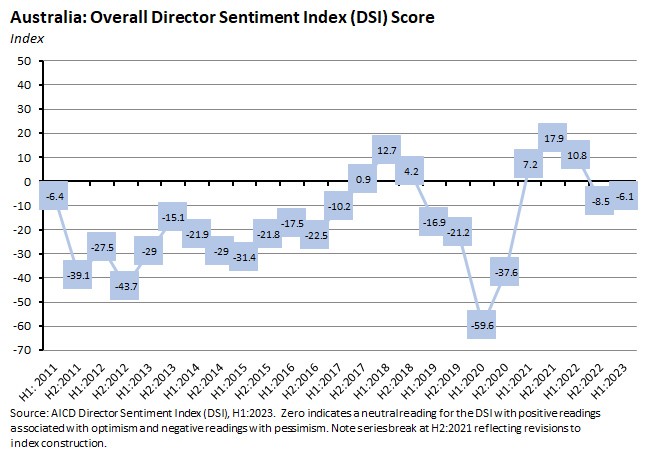
Breaking down the change in the DSI shows that much of the gain in sentiment this time relates to an improvement in directors’ views on the economic outlook, and in particular a marked improvement in the international economic outlook. Directors reported feeling more optimistic about all of China, Asia ex China, the United States and Europe. China enjoyed the biggest turnaround in sentiment, likely reflecting Beijing’s decision to exit from its zero-COVID strategy and that optimism looks consistent with recently released Q1:2023 GDP data, which showed Chinese consumers helping to drive a rebound in economic activity. The overall story is also consistent with the (pre-banking crisis) view that the world economy had ended last year on a stronger note than expected, thereby demonstrating a greater-than-anticipated resilience.
In contrast, the DSI reported that economic optimism relating to Australia had softened relative to the previous DSI. That said, the current economic readings for Australia were stronger than for any other region tracked by our survey, with more than half of our respondents judging the economic health of the economy as strong. And in terms of the economic outlook over the next 12 months, while about 32 per cent said the health of the Australian economy would be either somewhat or very weak, that was still outweighed by the 39 per cent who expected it to be somewhat or very strong.
Our measure of business conditions here in Australia likewise remained in positive territory in H1:2023, but fell 10 points relative to the H2:2022 reading, indicating a marked softening. That said, a greater share of directors rated current (42 per cent) and expected future (40 per cent) business conditions as strong rather than as weak (27 per cent said weak for current conditions, 30 per cent for future conditions).
The deterioration in economic and business conditions relative to the second half of last year is likely largely a product of the RBA’s campaign of monetary policy tightening in response to above-target inflation. Certainly, directors now see inflation and rising interest rates as the main economic challenge facing Australian businesses, while cost of living issues are also viewed as increasingly important.
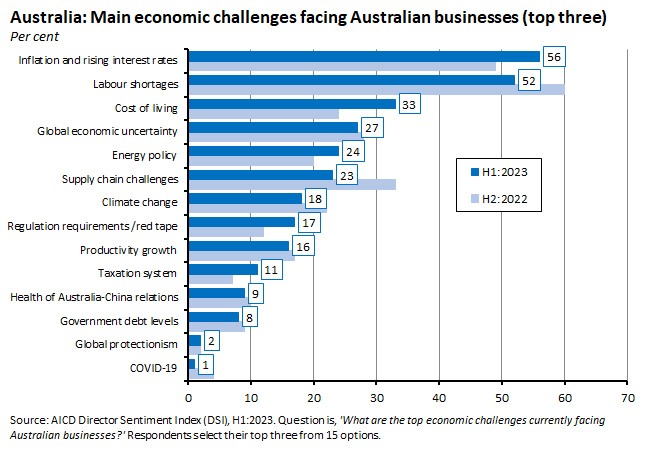
Labour shortages remain a key issue and are ranked as the second most important economic challenge. Interestingly, supply chain challenges have slipped out of the top five, consistent with the view that some of the worst of the pandemic-era disruption to logistics have now been unwound (although in answer to a separate question, 71 per cent of directors agreed that the war in Ukraine posed an ongoing risk to business supply chains)
As already noted, it’s no surprise that – during a resurgence of inflation and arguably the most brutal tightening of monetary policy in the inflation targeting era – inflation and interest rates now top the list of economic challenges. Some additional context for these issues is provided by a set of questions relating to the RBA (remembering again that the underlying polling took place before the central bank’s 4 April pause in rate hikes).
Here, the DSI shows notable increases relative to last year in the share of respondents judging that the current rate cycle is leading to an increased risk of a housing/mortgage crisis, a rise in business insolvency rates, and an outright recession.
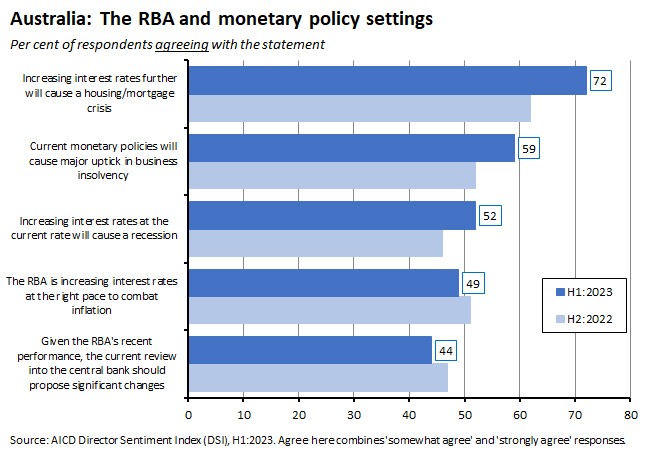
Indeed, now more than half of directors think that increasing rates at the pre-April 2023 rate would be likely to trigger a downturn in the Australian economy. Even so, it remains the case that almost half of directors think that the RBA is increasing rates at the right pace to combat inflation (vs. the 34 per cent who disagree). Interestingly, there has been a modest fall in the share of directors who agree that the RBA review should propose significant changes at Martin Place (vs. 29 per cent who disagree).
Finally on the RBA, there is little appetite for any additional government intervention in the institution. About 53 per cent of directors think the current level of intervention has been enough, while 29 per cent think there has been too much intervention, as opposed to the 18 per cent that think there has been too little.
Turning to the theme of labour market shortages, which has dominated recent DSIs, we can see that while there has been a slight retreat in the relative importance of these topics to directors, concerns remain extremely elevated.
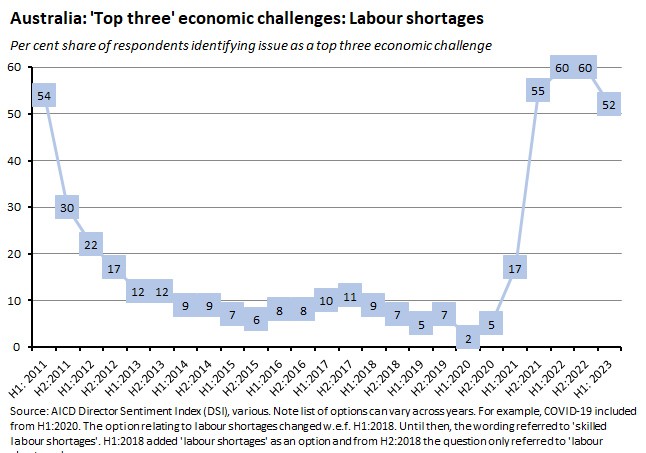
Some 93 per cent of our respondents agreed with the proposition that there is a skills shortage in the Australian workforce, 83 per cent agreed that skilled migration levels were not keeping up with labour demand and would impact growth and 74 per cent agreed that their organisation had been affected by labour market issues. Notably, given the current and sometimes breathless focus on generative AI and large language models (LLMs) in the media, only 29 per cent of directors agreed that the implementation of AI systems and workforce automation could resolve current skill shortages.
Staying with the labour market, the DSI also repeated a series of questions related to flexible working (remote work and WFH) that we also asked a year ago. The passage of time shows that directors have become more upbeat on some of the benefits offered by flexible work, while retaining the same concerns around the potential downsides.
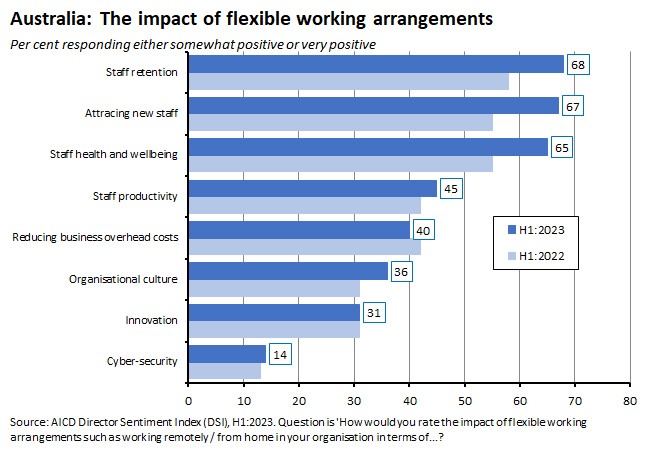
A greater share of directors now judge that these kind of working arrangements can have a positive impact on staff retention and attracting new staff (important given the current focus on labour shortages) and on staff health and wellbeing. Directors have also become somewhat more optimistic on implications for productivity, with 45 per cent assessing this as positive vs the 27 per cent who rated the impact as negative. But they also continue to be mindful of the costs and risks in terms of organisational culture (where 41 per cent rate the impact as somewhat or very negative), innovation (36 per cent negative) and in particular cyber-security, where a majority (51 per cent) of directors judged the impact to be negative.
Skills shortages once again tops the list of directors’ short-term policy priorities for the federal government, followed by energy policy and housing supply and affordability.
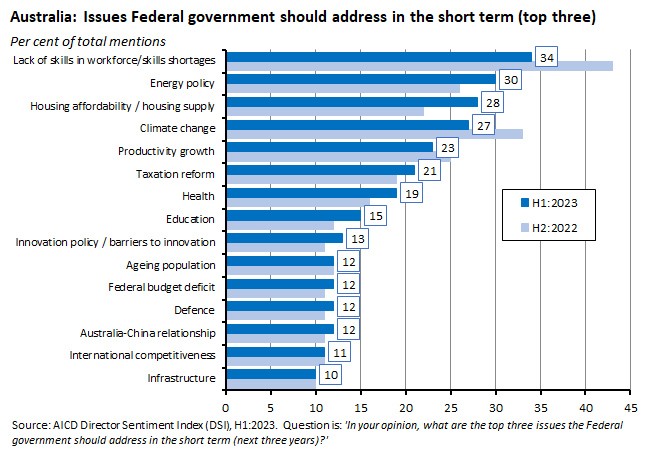
Meanwhile, climate change continues to top directors’ lists as the most important long-term federal government policy, followed by an ageing population and energy policy.
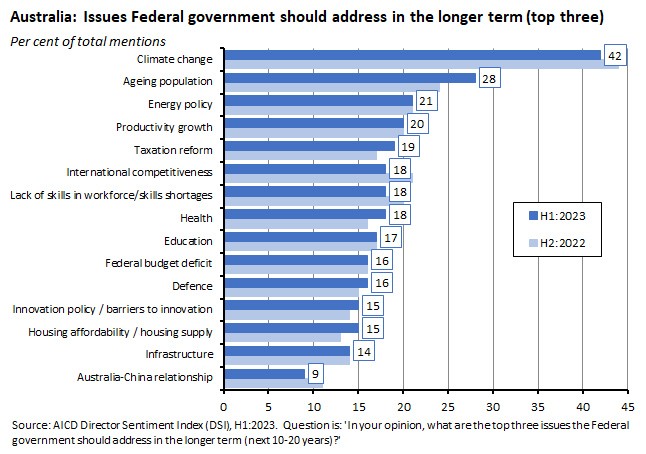
Finally, the issue that keeps directors awake at night more than any other is cyber crime/data security, nominated as a top three issue by 50 per cent of respondents and comfortably ahead of legal and regulatory compliance (32 per cent) and labour shortages (30 per cent).
The full DSI includes even more detail and an accompanying insights report is available here.
Finally, and once again, many thanks to all of you who were able to find the time to complete the survey.
Other things to note . . .
- From The Conversation website: Jeff Borland makes the case for Australia embracing a full employment target, Michelle Grattan says the Treasurer faces economic and political pressures pulling in different directions when it comes to setting the next budget and Andrew Podger on what he thinks the Grattan Institute gets wrong in its calls for superannuation reform.
- Beth Webster in the AFR argues that Australian businesses and government need to work together to develop alternative champion export industries to offset declining prospects for coal and iron ore.
- Three offerings on the economics of the pandemic from the latest issue of the Economic Papers journal: Chris Murphy on Australian fiscal policy in the COVID-19 era, Vo, Martinus and Smith on Medium-term post-pandemic consumption trends and Angelopoulos et al on Industry Diversity and COVID-19 policy effects.
- The world economy and the Mona Lisa effect.
- This issue of the BIS Bulletin examines the changing nexus between commodity prices and the US dollar. In the past, commodity prices and the green back have typically moved in opposite directions. But more recently they have moved in tandem, due to the unusual combination of recent shocks (a flight-to-safety into the US dollar and more rapid US monetary policy tightening than in other economies) and the impact of the US emergence as a net energy exporter (making the dollar behave more like a commodity currency). One consequence has been a compounding of the stagflationary effects of higher commodity prices for commodity importers, as now not only do higher commodity prices tend to stoke inflation and hinder growth in important economies, but a stronger US dollar tends to have the same impact outside the United States via its effect on international trade flows, particularly for emerging markets.
- A speech from the ECB’s Christine Lagarde on central banks in a fragmenting world. Lagarde warns fragmentation will have two profound effects on the policy environment – more instability (higher inflation, lower economic activity, and a fall in international trade) as global supply elasticity declines and more multipolarity (potentially encouraging new payment systems and the rise of alternative reserve assets) as geopolitical tensions rise.
- Henry Farrell considers Industrial policy and the new knowledge problem. Farrell argues that with a current resurgence in industrial policy, past scepticism about government ability to deliver in this area has left the public sector without the necessary skills to deliver on the new programs.
- Bert Hofman on politics and technology in China.
- The quest for the Eurochip. (Not, not the search for a fancier French fry).
- American Prospect magazine on the rise of the Climate Rating Agencies.
- Tracking EU-Russia decoupling.
- Martin Wolf in the FT warns that the UK needs faster economic growth to thrive and perhaps even survive as a peaceful and orderly democratic society, but its politicians appear unable to deliver.
- An OECD policy paper on critical raw materials for the green transition finds that export restrictions may be playing an increasingly important role in this corner of international trade.
- Noted, new World Bank publications looking at the outlook for South Asia and opportunities for Latin America in a changing global economy.
- Brad Delong reviews The Project-State and Its Rivals: A New History of the Twentieth and Twenty-First Centuries.
- Brookings podcast examining the risk of war over Taiwan.
- Odd Lots podcast on why much of the world economy may be going backwards.
Latest news
Already a member?
Login to view this content


